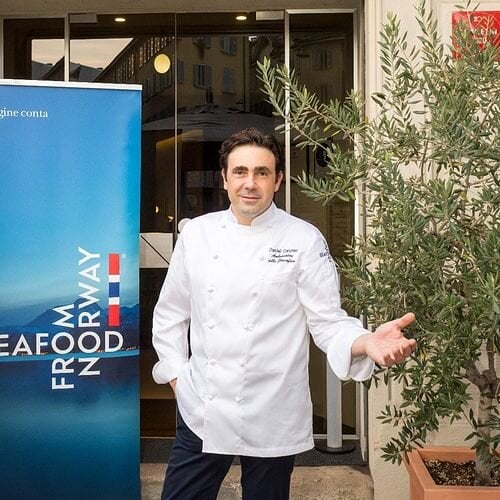More Italians are choosing seafood when eating out. Today, seafood has become the most popular protein on Italian menus.
More Italians are choosing seafood when eating out. Today, seafood has become the most popular protein on Italian menus.
Italy is one of Norway’s most important seafood markets. Here, salmon has almost overtaken pizza as a meal. Stockfish and clipfish also remain traditional dishes with deep roots, further cementing Italy’s love for Norwegian seafood. At the same time, Italians are more frequently opting for seafood in general when eating outside the home.
In 2024, 1.1 billion seafood dishes were served in Italian restaurants, cafés, and takeaway outlets—an increase of 3 percent compared to the previous year.
Against this backdrop, the Norwegian Seafood Council has commissioned two new reports exploring Italy as a seafood market and Italian seafood consumption. These reports provide valuable insights for both the Norwegian seafood industry and the Seafood Council.
“Information about consumers, purchasing groups, dining establishments, and market trends is a powerful tool to strengthen our efforts in the market,” says Tom-Jørgen Gangsø, the Norwegian seafood council’s country director in Italy.
Both reports are available on the Seafood Council’s website:
- Italian Seafood Market (log-in required)
- Out-of-Home Consumption Report – Italy (log-in required)
Full access to the reports requires login, but the following sections provide a brief summary of some key findings.
Fewer People Dine Out, but More Choose Fish

Italians love eating out. However, geopolitical uncertainty, the lasting effects of the pandemic, and inflation are impacting Italian households. People are worried about making ends meet and are cutting back on non-essential activities such as going to the cinema, theater, or dining at restaurants.
According to the out-of-home consumption report prepared by Circana for the Norwegian Seafood Council, 6 out of 10 Italians say they have changed their dining habits. In 2024, there were fewer restaurant visits compared to the previous year. Guests ordered fewer dishes, skipped expensive wines, and looked for deals, loyalty programs, and discount coupons.
Despite this, the number of seafood servings increased by 3 percent. Throughout the year, 1.1 billion dishes featuring seafood as the main ingredient were served. For salmon alone, the increase was 6 percent, while cod-based dishes grew by 5 percent.
Seafood consumption has particularly benefited from Italians returning to the office after the pandemic, as more people choose seafood for lunch—whether in the canteen or as a quick option like a wrap, sushi, or poke bowl on the go.
In 2024, there were 15 percent more lunch visits featuring fish on the menu compared to 2023.
Seafood More Popular Than Meat
Despite being more expensive than other proteins, seafood was the most consumed protein in Italian dining establishments in 2024, according to the Italian Seafood Market report. Measured by number of servings, fish and shellfish accounted for one in four dishes, closely followed by chicken/turkey (24%), beef (23%), and pork (20%).
These figures may be linked to Italians’ above-average focus on healthy and sustainable food. In addition, consumption is driven by many restaurants specializing in poke and sushi.
“We know that many people choose seafood dishes when dining out, because it’s something they don’t often prepare at home,” says Gangsø.
Among seafood, fish accounted for 70 percent of servings, while other seafood made up 30 percent. Across all types of dining venues, servings of salmon, cod products (including stockfish and salted fish dishes), and other fish increased, while tuna and shellfish declined. The picture is largely the same when comparing 2024 to the pre-pandemic year of 2019.
Both lunch and the traditional “aperitivo” are rapidly returning to pre-pandemic levels. “Aperitivo” refers to meeting up to relax and chat over a drink and some small dishes after work and before dinner.
The poke trend has had a major impact on the growth in salmon servings, particularly at lunch.
“Seafood’s share of the small dishes consumed after work is relatively small, but the potential is significant,” says Gangsø.
He highlights tapas featuring smoked salmon, stockfish, and baccalà as examples.
Read more: In the Homeland of Pizza, Salmon is Now as Popular as Pizza Itself.

From Independent Restaurants to Larger Chains
Italy has a high number of independent dining establishments compared to other countries. In 2024, nearly three-quarters of out-of-home seafood consumption took place at such venues.
However, the number of restaurant chains is growing rapidly, and in just one year (2023–2024), seafood servings in chains increased by 30 percent. Within this segment, the strongest growth is in the so-called Quick Service category—venues offering fast and convenient meals.
“That’s why we’ve started focusing more on promoting Norwegian seafood in this channel,” says Tom-Jørgen Gangsø.
He emphasizes that this comes in addition to campaigns in the retail sector, with the main focus on fully integrated campaigns where the Seafood Council works across multiple channels simultaneously.
The Origin of Seafood Matters to Italians

While independent restaurants dominate the Italian dining scene, the opposite is true for grocery stores, where numerous chains and stakeholders compete. Today, traditional supermarket chains account for half of seafood sales in retail, but discount chains are steadily gaining ground.
In addition to price, the origin of seafood is extremely important to Italian consumers:
- Nearly 9 out of 10 cares about where the seafood comes from
- 8 out of 10 expect the origin to be stated on the packaging
- 8 out of 10 believe origin indicates quality
- 7 out of 10 are willing to pay more for seafood with origin labeling
| Salmon | Stockfish | Baccalà | |||||||
| Norway | Scotland | Alaska/USA | Norway | Italy | Scotland | Norway | Italy | Scotland | |
| Awareness | 91% | 55% | 44% | 67% | 27% | 29% | 49% | 30% | 24% |
| Preference | 73% | 34% | 16% | 50% | 22% | 15% | 36% | 25% | 14% |
The table shows that Norwegian salmon, clipfish/saltfish, and stockfish enjoy high preference and awareness in Italy compared to competing countries. Norway is also the most preferred country of origin for salmon, stockfish, and baccalà (clipfish and saltfish), according to the Italian Seafood Market report. This underscores the importance of clearly labeling Norwegian seafood products with their origin.
Italians consume around 130,000 tons of Norwegian salmon annually, making Italy our third-largest consumer market for salmon. In addition, Italy is Norway’s most important market for stockfish and a country where people also eat a significant amount of Norwegian clipfish and saltfish.
In total, the value of direct Norwegian seafood exports to Italy reached NOK 7.4 billion in 2024.





